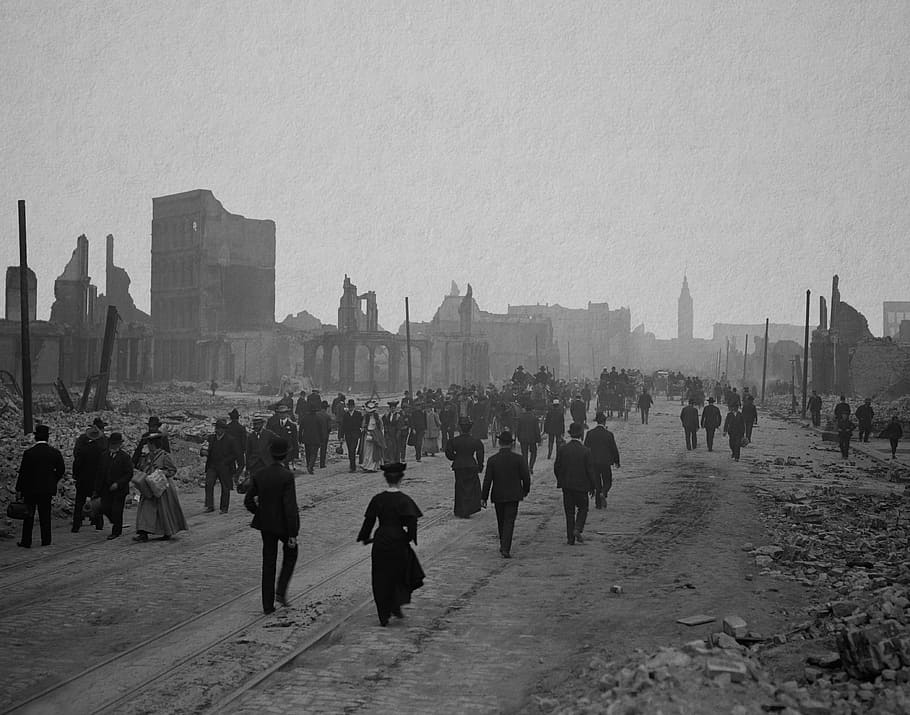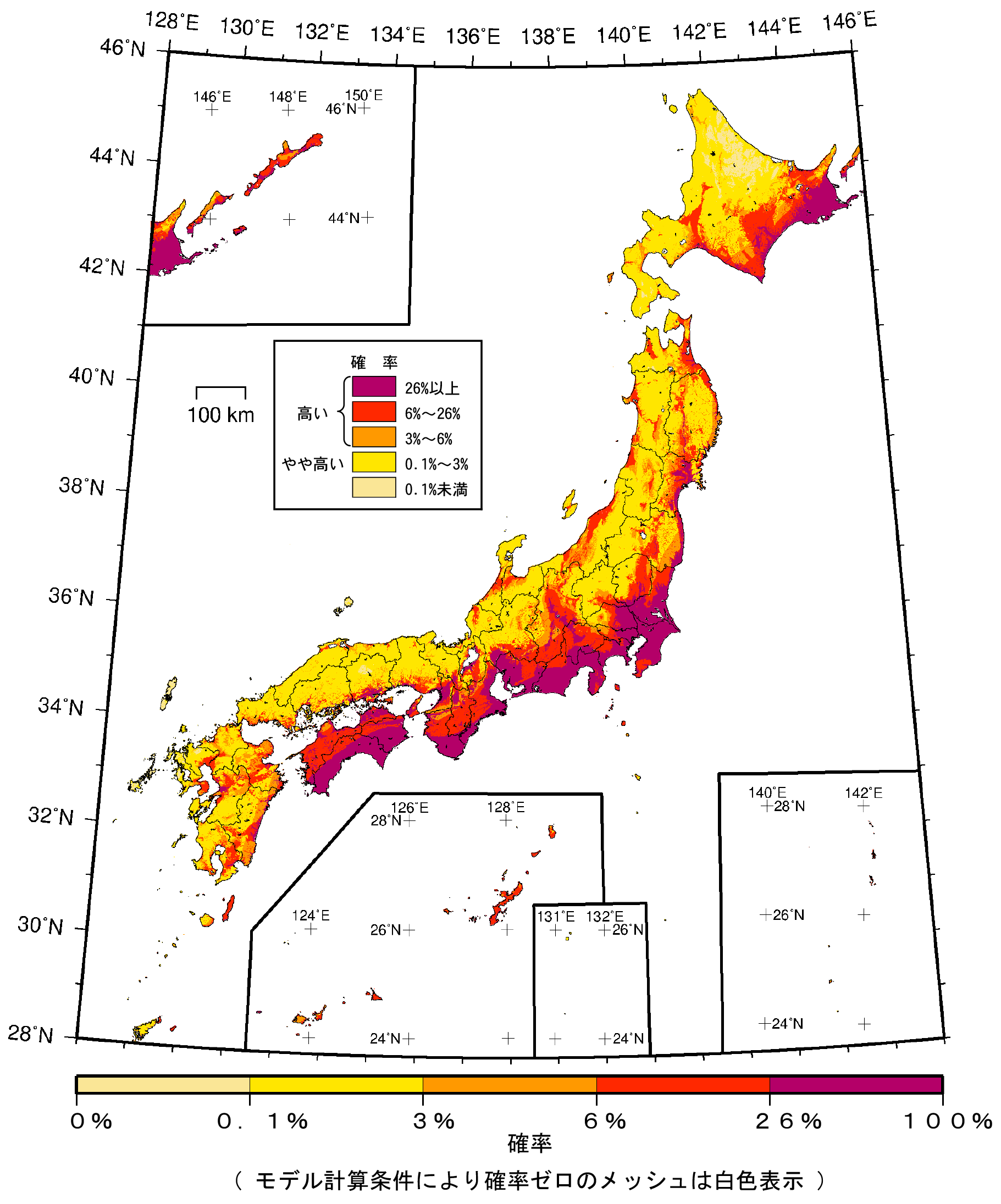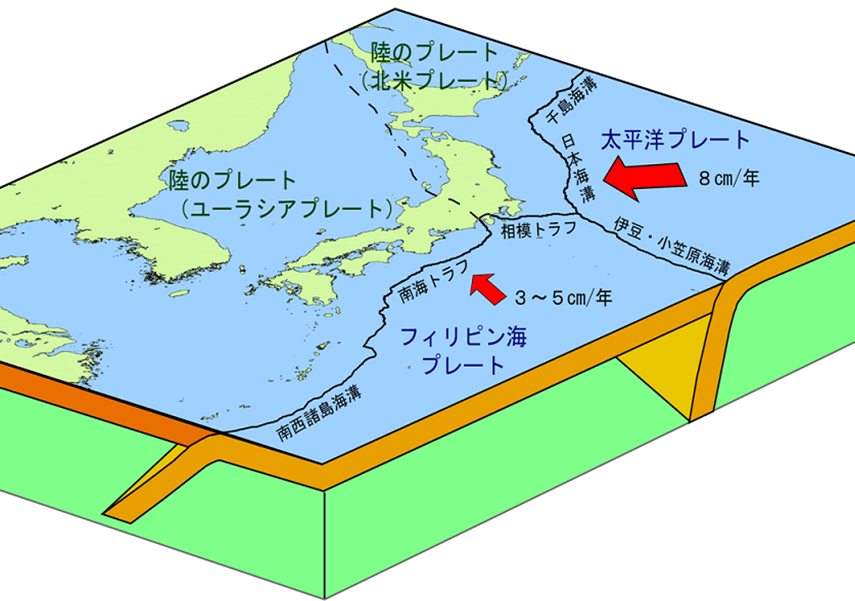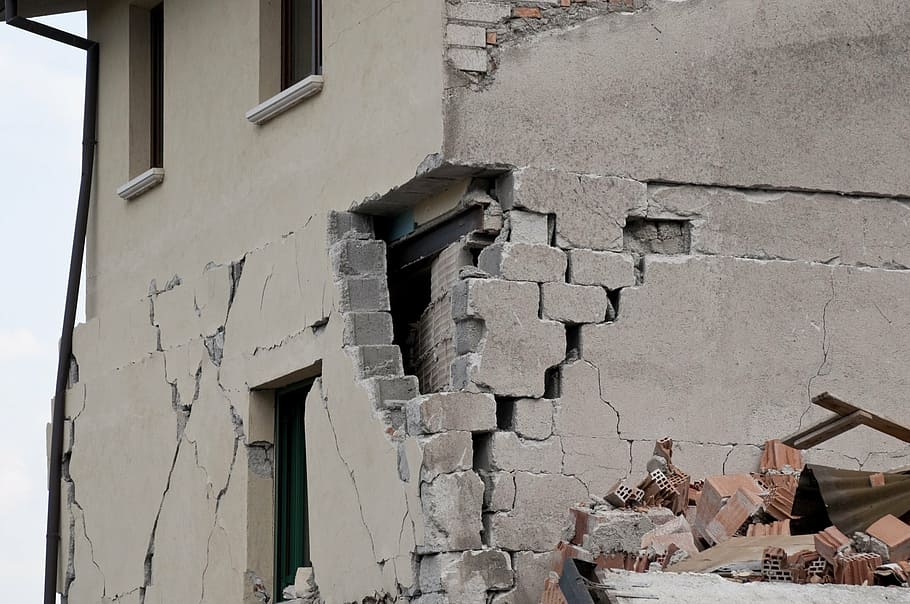キャプティブ 2022.01.14
CA33「首都圏直下大地震」に備えるキャプティブ
目次
- 1.地震調査研究推進本部
- 2.地震の種類
- 3.個人保険分野の地震保険の普及率
- 4.企業保険分野の地震保険の普及率
- 5.首都圏直下大地震
- 6.地震保険普及率の低さを改善するキャプティブ
- 今回のまとめ
- 1. Headquarters for Earthquake Research Promotion
- 2. Types of earthquakes
- 3. Penetration of earthquake insurance in the personal insurance sector
- 4. Penetration of earthquake insurance in the corporate insurance sector
- 5. Major earthquake directly below the Tokyo metropolitan area
- 6. Reasons for the low level of earthquake insurance penetration
- Summary of this issue
For those who prefer to read this column in English, the Japanese text is followed by a British English translation, so please scroll down to the bottom of the Japanese text.
大学を出て入社した外資系損害保険会社では、若くして全国の企業保険分野を統括する本社の枢要な立場に就かせていただき、素晴らしい上司やスタッフに恵まれていた。外資系損害保険会社としては日本最大、当時でも従業員は2000名を超え、日本の損害保険会社と比較しても中堅損保以上の規模を有していた。しかし、「本社」と言っても所詮「日本拠点の本社」であり、米国ニューヨークには世界を統括する「本物の本社」が存在していた。「箸の上げ下ろしまで」という表現が適切か解らないが、微細にニューヨーク本社にコントロールされながら、多少の息苦しさを感じる「本社の枢要な立場」であった。
まだ、血気盛んな30代であり、また、新入社員時代からニューヨーク本社には毎年のように出張、ニューヨーク本社の幹部とも知り合う機会も多く、「世界の損害保険のフィールドで働いてみたい」との思いが募っていた頃であった。親しい友人、知人には慰留されたが、「どうしても世界的な損害保険のフィールドで働いてみたい」と海外に出ることに挑戦、当時世界最大級の保険会社の一社、CIGNAコーポレーションから声を掛けていただき、米国フィラデルフィアの地で本社幹部の面接を受け、幸いなことに合格してフィラデルフィア本社のキャプティブ部門で勤めることになった。
その年の冬、上司から、「君は日本人だからクリスマス休暇というより、新年休暇の方が良いだろう」と、1994年の年末、休暇のために一時帰国。「日本の正月」をたっぷり味わい、翌1995年1月20日のフライトでフィラデルフィアに戻る予定にしていた。
その矢先、1月17日に起きたのが「阪神・淡路大震災」であった。早朝からのテレビ報道で被害の凄まじさを見せつけられ続けていた。日本拠点の社長に連絡を取ると、「直ちに被害状況の確認と損害保険金の支払いの調査に向かう」と言うので、思わず「こんななか、どうやって行くのですか?」と聞くと、「新幹線もクルマもダメだが、ようやくヘリコプターを2機チャーターできた、これで上空から撮影してそれを基に被害状況を掴んで早急に損害保険金を支払うように準備する」とのことであった。
当時CIGNAは、60階建ての本社ビルを2本、国際本部、国内本部としてフィラデルフィアの中心街に有していた。以前のコラムに記したが、フィラデルフィア本社で面接を終えた際、「CIGNA Museum(シグナ・ミュージアム(博物館))に連れて行ってあげなさい」とCEOに指示された副社長(EVP)に、その一つのビルの中にあった「シグナ・ミュージアム」に連れて行かれたことがある。「これが、1792年、当社最初の保険証券、ロンドンからフィラデルフィアへの航海中の貨物にかかわる海上保険証券です」と見せられ、伝統と格式を強く感じた。
その際、「CIGNAの懐の深さ」にも驚いた。米国の主要都市で起こった最も被害の大きい自然災害の一つ、被害総額が現在の価値で約100億ドル(1兆1千億円)に上った、1906年4月18日に起きた「サンフランシスコ地震」被害への対応である。米国の多くの保険会社は、「地震で倒壊した建造物は火災保険では補償されない」という条項をもとに保険金の支払いをしなかったが、シグナ・ミュージアムの壁に掲げられていた一枚のポスターには、「INA(CIGNAの前身)はサンフランシスコ大地震ではすべての火災保険に対して保険金を支払いました」と書いてあったからである。
その半年後、「米国で見たポスターの精神が、日本の地でもしっかり根付いている」と感じたこの日本拠点の社長との電話のことは今でもよく憶えている。

1906年のサンフランシスコ地震で移動手段が「徒歩のみ」となり、車道を歩く人々。
People walking along the roadway after the 1906 San Francisco earthquake, when the only way to get around was on foot.

写真左側に2本ある似た形の60階建ての超高層ビルは、CIGNAがフィラデルフィアに所有していたビルの写真であり、1本は「国内本部」もう1本には「国際本部」が入っていて、筆者の部屋は後者の50階にあった。CIGNAがどれほど巨大な企業だったのか、会社の偉容を物語る一枚の写真である。
The two similarly shaped 60-storey skyscrapers on the left of the photo are CIGNA’s buildings in Philadelphia, one housing the National Headquarters and the other the International Headquarters, and my room was on the 50th floor of the latter. It is a picture that shows how huge CIGNA was and how great the company was.
1.地震調査研究推進本部
この1995年1月17日発生した阪神・淡路大震災では、6,434名の犠牲者を出し、また10万棟を超える建物が全壊する戦後最大の被害をもたらしたが、併せて、日本政府内でも、「一元化されておらず、『司令塔』が存在しない地震防災対策に関する構造的な課題」を浮き彫りにすることになった。
こういった課題への対応として、同年7月、「全国の総合的な地震防災対策を推進して、全国の地震調査研究を一元的に推進するための政府機関」として、総理府内(現在は文部科学省内)に「地震調査研究推進本部」(略称「地震本部」)が設置された。
下図は、地震調査研究推進本部のホームページにある「地震に関する評価」のカテゴリーのなかで、「地震動予測地図」として、多くのマスメディアにも引用され多くの人々の目に触れた「全国地震動予測地図2020年版」であり、「今後30年間に震度6弱以上の揺れに見舞われる確率」について、「特定の地震に対して、ある想定されたシナリオに対する詳細な強震動評価に基づく『震源断層を特定した地震動予測地図』を合わせた『全国地震動予測地図』」と記されているものである
全国地震動予測地図2020年版
the 2020 edition of the National Seismic Hazard Map

確率論的地震動予測地図
Probabilistic seismic prediction map
今後30年間に震度6弱以上の揺れに見舞われる確率
Probability of experiencing an earthquake of intensity 6 lower or greater in the next 30 years
出典:「全国地震動予測地図2020年版」(地震調査研究推進本部)
Source: “the 2020 edition of the National Seismic Hazard Map”(the Headquarters for Earthquake Research Promotion)
2.地震の種類
地震は、一般的には「海溝型地震(プレート境界型地震)」と「断層型地震(直下型地震)」,この二つに大きく分けることができる。
海溝型地震(プレート境界型地震)は、プレートどうしが接している境界で発生する地震である。下図のように、日本列島は地質学的には、「ユーラシアプレート」と「北米プレート」の境、大地溝帯である「フォッサマグナ」によって、「プレート」が別れていて、日本列島の西半分は「ユーラシアプレート」、北海道を含めた東半分は「北米プレート」と、「乗っている土台」によって別れている。
先週の「コラム」(CA32 「富士山噴火」に備えるキャプティブ)に、「2021年10月から12月に掛けて放映されたTBSのドラマ『日曜劇場』『日本沈没ー希望のひとー』、筆者もその引き込まれるような物語の展開に毎週欠かさず見ていたが、その最終回で、『富士山が大噴火するシーン』が描かれていたのが印象的であった。」と記したが、もう一つ印象的なシーンが「富士山の大噴火後、その『フォッサマグナ』を中心にして日本列島が二つに裂けて海中に没していく場面」であった。
この「日本列島が裂けた」シーンは、「日本列島が成り立っている土台が、『ユーラシアプレート』と『北米プレート』と二つ別々に存在していること」を背景に、「二つのプレートがそれぞれ動くと日本列島が裂け、その大半が海中に没するはず」という着想からできあがった場面であろう。

(出典:「気象庁ホームページ」)(Source: Japan Meteorological Agency (JMA )website)
日本列島の西半分側、「九州から西日本を形成している土台」である「ユーラシアプレート」に海側の「フィリピン海プレート」が沈み込んでいる場所が「南海トラフ」であり、「南海トラフ巨大地震」の発生が懸念されている場所である。「フォッサマグナ」の東側、北海道、日本列島の東半分の土台が「北米プレート」であり、そこに海側の「フィリピン海プレート」が沈み込んでいる場所が「関東大震災」をはじめ、これまで関東圏に多くの地震災害をもたらした「相模トラフ」である。
そして、「太平洋プレート」が「北米プレート」に沈み込んでいる場所が千島海溝、日本海溝であり、東日本大震災クラスの巨大な「海溝型地震」の発生が危惧されている場所である。
一方、海側のプレートが陸側のプレートに潜り込んでいくときに陸側のプレート内部に蓄積された歪みである「断層」がずれて、震源の浅い地震が発生するのが「断層型地震」であり、一般的には「直下型地震」と呼ばれているものである。この地震は居住地の直下で発生するため、震源が浅い場合には、局所的に激しい揺れが起こり、家屋の倒壊や火災などを引き起こし、直接的な大きな被害をもたらす。「阪神・淡路大震災」がこれにあたる。
関東地方は北米プレート上にあるが、フィリピン海プレートが北米プレートの下に潜り込んでいく境目に形成された相模トラフが関東大震災の震源になった点で関東大震災は「海溝型地震」となる。
被害想定の大きさ、全国規模の被害の拡大という点から南海トラフ巨大地震の陰に隠れがちであるが、関東圏全域を襲う「首都圏直下地震」は日本の首都東京に甚大な被害を与え、日本の首都機能を奪う可能性があるという点から万全の備えが非常に必要であることは論を待たないであろう。しかし、その備えは万全とはなっていないようである。
3.個人保険分野の地震保険の普及率
個人保険分野の地震保険の普及率に関しては、「損害保険料率算出機構」による加入統計がある。その「損害保険料率算出機構統計集2020年度版地震保険統計」によると、2020年における地震保険の日本全国での世帯加入率は33.9%にすぎない。東日本大震災を経験して大きな被害を受けた、宮城県でも51.9%、岩手県は25.9%、首都圏直下地震が懸念される東京都ではわずか37.7%の加入率である。
これまでのコラムに記してきたとおり、「地震保険」という保険は存在せず、「地震リスクへの補償」を受ける保険は、火災保険を「主契約」として、その主契約に「地震リスクを補償する特約」(地震危険補償特約)を付帯することによって構成する。つまり、「主契約」となる火災保険の加入率が低ければ当然その「特約」である「地震危険補償特約」、一般的に「地震保険」と通称されている保険の加入率も低くなるのである。言い換えると、そもそも火災保険の加入率が低いために地震保険の加入率も低いという事象となって表れていると言えるのである。
では、火災保険を購入した世帯では、どれくらいの割合で地震保険(地震危険補償特約)を購入しているのであろうか。同様に上述の加入統計を見ると、火災保険を購入している世帯では、その火災保険への地震保険の付帯率は68.3%となっている。東日本大震災で大きな被害を受けた宮城県では、火災保険を購入した世帯の実に87.5%が「地震保険」に加入している。しかし、震源から離れていた東京都の数字は61.7%と低く、地震への備えは弱いと言わざるを得ない。
4.企業保険分野の地震保険の普及率
個人保険分野の地震保険は、損害保険会社が引き受けても最終的には政府が全てのリスクを再保険の形で引受けている。そのため、損害保険料率算出機構のような公的な機関が詳細な統計をとっているが、企業保険分野の「地震保険」では、政府が再保険を受けることもなく各損害保険会社の引受力(海外の地震再保険の調達力)次第であるため、そのような詳細な統計は存在していない。
しかし、政府、内閣府が2017年に実施した調査では、「2011年の東日本大震災の際に地震保険に加入していた大企業の割合は36%であり、中小企業では10%以下であったこと」が示されている。2兆円以上におよぶ東日本大震災による経済的損失額のうち、僅か十数%しか補償されなかった理由がここにある。その後、地震保険を購入する企業は増加したが、依然として多くの企業が地震保険に加入していないのが実状であり、残念ながら、切迫している大地震に対しての備えは脆弱と言わざるを得ないのが実状である。
5.首都圏直下大地震
甚大な被害をもたらした東日本大震災における政府の対応を検証して、首都直下地震、東海・東南海・南海地震(「三連動大地震」)等の大規模災害、豪雨災害に備え防災対策の強化を図るため、2011年10月11日の政府中央防災会議に於いて、新たな専門部会として「防災対策推進検討会議」が設置され、首都圏直下地震に関しては、2012年3月7日防災対策推進検討会議に於いて、「首都直下地震対策検討ワーキンググループ」の設置が決定された。
2013年12月19日公表された「首都直下地震対策検討ワーキンググループ最終報告の概要」によると、政府は、直下型地震としては一般的な居住地直下の断層が動くことによって起こる「断層型地震」(1)、関東大震災と同じく「相模トラフ」が動く「海溝型地震」(2)、この二つを「首都圏直下地震」として、次のようにその被害を想定している。
(1) 首都直下のM7クラスの地震 【都心南部直下地震(Mw7.3)】(30年間に70%の確率で発生) 防災対策の主眼を置く
(2) 相模トラフ沿いのM8クラスの地震 【大正関東地震タイプの地震(Mw8.2)】(当面発生する可能性は低い) 長期的視野に立った対策の実施
その「被害想定(人的・物的被害)の概要」は次の通りとなっている。
| 1.地震の揺れによる被害 (1) 揺れによる全壊家屋:約175,000棟 建物倒壊による死者:最大 約11,000人 (2) 揺れによる建物被害に伴う要救助者:最大 約72,000人 |
| 2.市街地火災の多発と延焼 (1) 焼失: 最大 約412,000棟、 建物倒壊等と合わせ最大 約610,000棟 (2) 死者: 最大 約 16,000人、 建物倒壊等と合わせ最大 約 23,000人 |
| 3.インフラ・ライフライン等の被害 (1) 電力:発災直後は都区部の約5割が停電。供給能力が5割程度に落ち、1週間以上不安定な状況が続く (2) 通信:固定電話・携帯電話とも、輻輳のため、9割の通話規制が1日以上継続。メールは遅配が生じる可能性。携帯基地局の非常用電源が切れると停波。 (3) 上下水道:都区部で約5割が断水。約1割で下水道の使用ができない。 (4) 交通:地下鉄は1週間、私鉄・在来線は1か月程度、運行停止する可能性。主要路線の道路啓開には、少なくとも1~2日を要し、その後、緊急交通路として使用。都区部の一般道はガレキによる狭小、放置車両等の発生で交通麻痺が発生。 (5) 港湾:非耐震岸壁では、多くの施設で機能が確保できなくなり、復旧には数か月を要す。 (6) 燃料:油槽所・製油所において備蓄はあるものの、タンクローリーの確保、深刻な渋滞により、非常用発電用の重油を含め、軽油、ガソリン、灯油とも末端までの供給が困難となる。 |
| 4.経済的被害 (1) 建物等の直接被害:約47兆円 (2) 生産・サービス低下の被害:約48兆円 合計:約95兆円 |

6.地震保険普及率の低さを改善するキャプティブ
政府の地震調査研究推進本部が公式に表明しているとおり、「甚大な被害をもたらす可能性のある大地震発生の可能性は高い」。しかし、地震保険の加入率は低いままである。その理由はどこにあるのか。ひとえに「保険料が高い」と見なされているからであろう。首都圏では、個人保険分野の地震保険でも、主契約である火災保険料の約4倍から5倍の保険料になる。保険金額が非常に大きな企業向け地震保険では、地震保険料は非常に高いものとなっている。しかし、この地震保険料は何も根拠も理由も無く決定されたものではなく、「リスク応分の保険料」なのである。
企業保険分野の地震保険の保険料も同様である。グローバル・リンクがキャプティブの設立コンサルティングをおこない、その運営管理を任されている実例でも、保険金額800億円に対して主契約である火災保険料は2000万円、これに対して地震保険料は2億8000万円、10倍以上の差である。
もし、この地震保険料が「掛け捨てのまま」であれば、果たして地震保険を購入されたであろうか。答えは「否」である。「キャプティブの設立によって、実質的な地震保険コストが安くなったから購入の決断をした」というのがその顧客の地震保険購入の理由であったからである。
キャプティブを設立することによって、世界最大級の海外の再保険会社がキャプティブからの再保険を引受ける。つまり、世界最大級の海外の再保険会社が、最終的に地震リスクを引受ける。しかも、その世界最大級の海外の再保険会社がそのリスクを引受ける保険料、つまり「キャプティブからの再保険料」は8000万円である。この結果、「2億8000万円の保険料全額が掛け捨てにならず」に、そこで生まれた「内外価格差」によって毎年2億円あまりが「キャプティブの収益」となるプログラムだからである。
今回のまとめ
京都大学の鎌田浩毅名誉教授執筆の「首都圏直下地震と南海トラフ」(MdN新書)には次の一文がある。
日本列島が「動く大地」となってしまった以上、そこで生きていく私たち一人ひとりが、この事実を受け入れて「覚醒」しなければなりません。これまでと違った考え方、行動力を持つ必要があるのです。
前述のとおり、政府は、首都圏直下地震が起きた場合の被害予想は、最大で1万1000人の犠牲者、全壊、焼失家屋61万棟、95兆円の経済被害が出ると想定しているが、鎌田名誉教授は、「東日本大震災によって事実上、東日本の内陸部では首都圏も含めて直下型地震が起きる確率が高まった、と考えた方がよいでしょう」と同書で警鐘を鳴らしている。
日本は、地震・津波などの地震災害国であるにも関わらず、国内の損害保険会社が販売する一般的な地震保険商品では、企業が必要とする高額の補償を確保することは困難な状況が続いていると言われている。一方、海外の保険市場には、巨大な保険引受力(キャパシティ)が存在するため、国内の一般的な企業向け地震保険商品では提供できない高額の補償を廉価で得ることができる可能性が高い。
日本損害保険協会の行動規範には、「安心かつ安全で持続可能な社会の実現と、経済および国民生活の安定と向上に資する相互扶助制度を円滑に運営することが、損害保険事業の社会的使命として求められている」とある。
つまり、損害保険会社はその社会的使命として、「ある特定の一社にのみ補償を提供することではなく、日本国内の個人、企業に遍く広く補償を提供すること」が求められている。「一社のみの要望に応える存在」になることはできない。だからこそ、「一社のみの要望に応えるキャプティブ」が果たす役割は非常に大きいと言えるのである。
さらに、前述のとおり、海外に設立したキャプティブを通じ、海外の保険市場からキャプティブの再保険を廉価で確保することによって、元受保険会社と海外の保険会社との保険料の差額はキャプティブの利益となる。
グローバル・リンクが提唱する「ソリューション・キャプティブ®・プログラム」とは、電気機関車が登場する前、蒸気機関車を2両以上連結して険しい山越えをおこなった「重連運転」(俗称「トンボ連結」)のように、「世界最大級の再保険会社と日本の最大級の保険会社(元受保険会社)がキャプティブを『連結器』にして連携、連結して、一見不可能と思えるような『補償の提供』を廉価で可能にするプログラム」ということができるであろう。
オミクロン株の弱毒化、ワクチン接種による軽症化等の報道により、感染者は増えるが重症化は防げていて、コロナ禍の先に、薄日が垣間見えるようになってきたいま、次なる巨大リスクである首都圏直下大地震、南海トラフ巨大地震等に備えるため、前述の鎌田浩毅京都大学名誉教授の「これまでと違った考え方、行動力を持つ必要があるのです」という警鐘に従って、新たな発想で「キャプティブの設立」を検討する良い機会ではないだろうか。
執筆・翻訳者:羽谷 信一郎
English Translation
Captive (CA) 33 – Captives prepared for a major earthquake striking the Tokyo metropolitan area
At the foreign non-life insurance company I joined after graduating from university, I was given a pivotal position at the head office, overseeing the corporate insurance sector nationwide at a young age, and was blessed with excellent superiors and subordinates. The company was the largest foreign non-life insurance company in Japan, with more than 2,000 employees even at that time, and was larger than a medium-sized non-life insurance company in comparison with Japanese non-life insurance companies. However, the “head office” was only the “head office in Japan”, and there was a “real head office” in New York that controlled the whole world. I don’t know if it’s appropriate to call it “chopsticks up and down”, but I was in the “pivotal position of the head office”, feeling a bit suffocated while being controlled by the New York head office.
I was still in my thirties and had been traveling to the New York head office every year since I was a new employee, so I had many opportunities to get to know the executives there. Although his close friends and acquaintances consoled him, he challenged himself to go abroad, saying “I really want to work in the global non-life insurance field. CIGNA Corporation, one of the largest insurance companies in the world at the time, approached me and I was fortunate enough to have an interview with a senior executive at their headquarters in Philadelphia, USA.
In the winter of the same year, my boss said to me, “Since you are Japanese, I think it would be better for you to have a New Year holiday rather than a Christmas holiday”, so at the end of 1994, I went back to Japan for a holiday. I had planned to take a flight back to Philadelphia the following year on a flight on 20 January 1995 to enjoy the “Japanese New Year”.
Just then, on January 17th, the Great Hanshin-Awaji Earthquake struck. The early morning television reports continued to show the horrific extent of the damage. When I contacted the president of the Japan office, he said that he would immediately go to Osaka to assess the damage and investigate the payment of insurance claims. I asked him how he was going to get there in such a situation, and he replied that neither the bullet train nor cars were available, but that he had finally chartered two helicopters to take pictures from the sky, which would be used to assess the damage and prepare to pay the insurance claim as soon as possible.
At the time, CIGNA had two 60-story buildings in downtown Philadelphia, one for its international headquarters and one for its national headquarters. As I mentioned in a previous column, after an interview at the Philadelphia headquarters, I was taken to the CIGNA Museum in one of the buildings by the EVP, who was instructed by the CEO to take me to the CIGNA Museum. He showed me “This is our first insurance policy, a marine insurance policy for a cargo on a voyage from London to Philadelphia in 1792”.
At that time, I was surprised by the depth of CIGNA. This was in response to the San Francisco earthquake of April 18, 1906, one of the most devastating natural disasters to ever hit a major US city, with damage totalling about $10 billion (¥1.1 trillion) in today’s terms. Many insurance companies in the US did not pay out on the basis of a clause stating that fire insurance would not cover buildings destroyed by the quake, but a poster on the wall of the CIGNA Museum read: “INA (the predecessor of CIGNA) paid out on all fire insurance policies in the San Francisco earthquake.”
I still remember the phone call I had six months later with the president of this Japanese office, who was impressed that the spirit of the poster I had seen in the US had taken root in Japan.
1. Headquarters for Earthquake Research Promotion
The Great Hanshin-Awaji Earthquake of 17 January 1995, which killed 6,434 people and destroyed over 100,000 buildings, was the most devastating earthquake in post-war history, but it also brought to light structural problems within the Japanese government concerning earthquake disaster prevention measures, which were not centralised and had no “control tower”.
In July of the same year, the Headquarters for Earthquake Research Promotion (abbreviated “Earthquake Headquarters”) was established in the Prime Minister’s Office (now part of the Ministry of Education, Culture, Sports, Science and Technology) as “a government agency to promote comprehensive earthquake disaster prevention measures throughout Japan and to centralise earthquake research throughout the country”.
The figure below shows the 2020 edition of the National Seismic Hazard Map, which has been cited by many in the mass media and has been seen by many people, states that “the probability of earthquakes of intensity 6 lower occurring in the next 30 years” is based on “the National Seismic Hazard Map, which is a combination of “earthquake motion prediction maps that identify the source fault’ based on detailed strong motion assessments for specific earthquake scenarios”.
2. Types of earthquakes
Earthquakes can be divided into two general categories: trench earthquakes (plate boundary earthquakes) and fault earthquakes (direct earthquakes).
Trench earthquakes (plate boundary earthquakes) are earthquakes that occur at the boundary between two tectonic plates. As shown in the figure below, geologically speaking, the Japanese archipelago is divided by the boundary between the Eurasian Plate and the North American Plate, and by the Fossa Magna, which is the Great Rift Valley. The western half of the Japanese archipelago is on the Eurasian Plate and the eastern half, including Hokkaido, is on the North American Plate.
In last week’s column (CA32: Captives prepare for Mt Fuji eruption), the author wrote: “I watched the TBS drama “Sinking of Japan: A Man of Hope” from October to December 2021 without fail. Fuji erupting in the final episode. After Fuji erupted, the Japanese archipelago split in two around the “Fossa Magna” and was submerged in the sea.
This scene of the Japanese Islands being ripped apart was probably inspired by the fact that the Japanese Islands are made up of two separate plates, the Eurasian Plate and the North American Plate, and that when each of the two plates moves, the Japanese Islands should be ripped apart and most of them submerged in the sea.
The western half of the Japanese archipelago, where the Philippine Sea Plate on the sea side sinks into the Eurasian Plate, which is the foundation that forms Kyushu to western Japan, is the Nankai Trough, and it is a place where there is concern about the occurrence of a huge Nankai Trough Great Earthquake. To the east of the Fossa Magna, Hokkaido and the eastern half of the Japanese archipelago is the North American Plate, and where the Philippine Sea Plate sinks into the North American Plate is the Sagami Trough, which has caused many earthquakes and disasters in the Kanto region, including the Great Kanto Earthquake.
The Pacific Plate is subducted by the North American Plate in the Kuril Islands Trench and the Japan Trench, where there are fears of a massive trench-type earthquake of the magnitude of the Great East Japan Earthquake.
The Kanto region is on the North American Plate, but the Great Kanto Earthquake was a “trench earthquake” in that the epicentre was the Sagami Trough, which was formed at the boundary of the Philippine Sea Plate going under the North American Plate.
Although it is often overshadowed by the Nankai Trough earthquake because of the size of the estimated damage and the spread of damage across the country, it is undeniable that we need to take every possible precaution to prepare for an earthquake directly below the Tokyo metropolitan area, which would hit the entire Kanto region, causing enormous damage to the capital city of Japan and possibly taking away the functions of the Japanese capital. But we are not fully prepared. However, it seems that there is not enough preparation for this.
3. Penetration of earthquake insurance in the personal insurance sector
With regard to the penetration rate of earthquake insurance in the personal insurance sector, the Non-Life Insurance Rating Organization of Japan(NLIRO) provides statistics on the subscription rate. According to the “Non-Life Insurance Rating Organization of Japan Statistics on Earthquake Insurance for 2020”, the household subscription rate for earthquake insurance in Japan in 2020 is only 33.9%. In Miyagi Prefecture, which was hit hard by the Great East Japan Earthquake, only 51.9% of households have earthquake insurance, in Iwate Prefecture 25.9%, and in Tokyo, where there are fears of an earthquake striking the Tokyo metropolitan area, only 37.7% have earthquake insurance.
As I have written in my previous columns, there is no such thing as “earthquake insurance”, and insurance that provides “compensation for earthquake risk” consists of a fire insurance policy as the “main policy”, to which is added a “special clause to compensate for earthquake risk” (special clause to compensate for earthquake risk). In other words, if the take-up rate of fire insurance, which is the main policy, is low, the take-up rate of the special clause for earthquake risk compensation, commonly known as “earthquake insurance”, will also be low. In other words, the low take-up rate of fire insurance in the first place is reflected in the low take-up rate of earthquake insurance.
What proportion of households that have purchased fire insurance have also purchased earthquake insurance (special clause for earthquake risk compensation)? Similarly, the above-mentioned subscription statistics show that, for households that have purchased fire insurance, the rate of earthquake insurance attached to that fire insurance is 68.3%. In Miyagi Prefecture, which was severely damaged by the Great East Japan Earthquake, a whopping 87.5% of households that purchased fire insurance purchased “earthquake insurance”. However, the figure for Tokyo, which was far from the epicentre of the earthquake, was a low 61.7%, suggesting that earthquake preparedness is weak.
4. Penetration of earthquake insurance in the corporate insurance sector
Earthquake insurance in the private insurance sector is underwritten by non-life insurance companies, but ultimately the government underwrites all risks in the form of reinsurance. For this reason, public institutions such as the Non-Life Insurance Rating Organization of Japan(NLIRO)keep detailed statistics on earthquake insurance, but there are no such detailed statistics on earthquake insurance in the corporate insurance sector, as the government does not underwrite reinsurance and it depends on the underwriting capacity of each non-life insurance company (i.e. its ability to procure overseas earthquake reinsurance).
However, a survey conducted by the government and the Cabinet Office in 2017 showed that “36% of large companies and less than 10% of small and medium-sized companies had earthquake insurance at the time of the Great East Japan Earthquake in 2011”. This explains why only a dozen percent of the more than ¥2 trillion in economic losses caused by the disaster were covered. Although the number of companies purchasing earthquake insurance has increased since then, the reality is that many companies still do not have earthquake insurance, and unfortunately, their preparedness for an impending major earthquake is weak.
5. Major earthquake directly below the Tokyo metropolitan area
In order to review the government’s response to the Great East Japan Earthquake, which caused enormous damage, and to strengthen disaster prevention measures in preparation for large-scale disasters such as earthquakes directly below the Tokyo metropolitan area, and earthquakes in the Tokai, Tonankai, and Nankai regions (the “triple-linked great earthquakes”), as well as heavy rainfall disasters, the Government of Japan established the “Council for Promotion of Disaster Prevention Measures” as a new specialized subcommittee at the Central Disaster Management Council on October 11, 2011. With regard to earthquakes directly beneath the Tokyo metropolitan area, on March 7, 2012, the Disaster Prevention Promotion Council decided to establish a Working Group to Study Measures for Earthquakes Directly Below the Tokyo Metropolitan Area.
According to the “Summary of the Final Report of the Working Group on Countermeasures for Earthquakes Directly Beneath the Tokyo Metropolitan Area” published on 19 December 2013, the government has identified two types of earthquakes as “earthquakes directly beneath the Tokyo metropolitan area”: (1) fault-based earthquakes, which are generally caused by the movement of faults directly beneath residential areas, and (2) trench-based earthquakes, which are caused by the movement of the Sagami Trough, as in the Great Kanto Earthquake. These two types of earthquakes are called “earthquakes directly under the Tokyo metropolitan area”, and their damage is assumed as follows.
(1) M7 class earthquake directly below the Tokyo metropolitan area (Mw7.3) (70% probability of occurrence in 30 years) (70% probability of occurrence in 30 years) ・・・・・ The main focus of disaster prevention measures
(2) M8 class earthquake along the Sagami Trough [Taisho Kanto Earthquake type earthquake (Mw 8.2)] (Low probability of occurrence for the time being) ・・・・・ Implementation of measures from a long-term perspective
The following is a summary of the damage estimates (human and physical damage).
| 1. Damage caused by earthquake shaking
(1) Totally destroyed houses due to tremors: approx. 175,000 |
| 2. High incidence and spread of urban fires (1) Burned: Max. 412,000 houses, Max. 610,000 houses including collapsed buildings (2) Death toll: Max. 16,000, Max. 23,000 including collapsed buildings |
| 3. Damage to infrastructure and lifelines (1) Electricity: Immediately after the disaster, approximately 50% of the Tokyo metropolitan area was without power. The supply capacity dropped to about 50%, and the situation remained unstable for more than a week. (2) Telecommunications: 90% of fixed-line and mobile phone calls will be restricted for at least one day due to congestion. There is a possibility of late delivery of e-mails. Mobile phone service will be suspended when the emergency power supply of mobile base stations is cut. (3) Water supply and sewerage: Water supply has been cut off in about 50% of metropolitan areas. Sewerage is not available in about 10% of the city. (4) Transportation: Subway service may be suspended for one week, private railways and conventional lines for about one month. It will take at least one or two days to clear the roads on major routes, after which they will be used for emergency traffic. General roads in the metropolitan area will be narrow due to debris, and traffic will be paralyzed due to abandoned vehicles. (5) Ports and Harbours: Many of the non-seismic quays will not be able to function, and it will take several months to restore them. (6) Fuel: Although there are stockpiles at oil depots and refineries, it will be difficult to secure tank lorries and supply light oil, gasoline and paraffin to the end of the line, including heavy oil for emergency power generation, due to severe traffic congestion. |
| 4. Economic damage (1) Direct damage to buildings, etc.: approx. 47 trillion yen (2) Damage to production and services: approx. 48 trillion yen Total: approx. 95 trillion yen |
6. Reasons for the low level of earthquake insurance penetration
As the Government’s Headquarters for Earthquake Research Promotion has officially stated, the probability of a major earthquake with the potential to cause enormous damage is high, yet the take-up rate of earthquake insurance remains low. What are the reasons for this? In the Tokyo metropolitan area, the individual insurance sector is the most important. In the Tokyo metropolitan area, the premiums for earthquake insurance in the personal insurance field are about four to five times higher than those for fire insurance, the main policy. For corporate earthquake insurance, where the sum insured is very large, the earthquake insurance premiums are very high. However, the earthquake insurance premiums are not determined without any rationale or reason, but are a “premium for risk”.
The same applies to earthquake insurance premiums in the corporate insurance sector. In the case of the captive that Global Link consulted on setting up and managing, the premium for the main fire insurance policy was 20 million yen, compared to 280 million yen for the earthquake insurance policy, a difference of more than 10 times.
If the premiums for earthquake insurance was non-refundable insurance, would the insured have purchased earthquake insurance? The answer would be “no”. The client’s reason for buying earthquake insurance was that “the establishment of the captive reduced the real cost of earthquake insurance, so we made the decision to buy it”.
By establishing a captive, one of the world’s largest foreign reinsurance companies will underwrite reinsurance from the captive. This means that one of the world’s largest foreign reinsurers will ultimately underwrite the earthquake risk. Furthermore, the premium for the risk underwritten by the world’s largest overseas reinsurer, i.e. the “reinsurance premium from the captive”, is 80 million yen. As a result, “the full ¥280 million in premiums will not be non-refundable”, but the resulting “internal domestic and external foreign price differential” will generate over ¥200 million annually for the captive.
Summary of this issue
In the book “The Earthquake Directly Below the Tokyo Metropolitan Area and the Nankai Trough” (MdN Shinsho), written by Professor Emeritus Hiroki Kamata of Kyoto University, there is the following sentence
Since the Japanese archipelago has become a “moving land”, each of us who live there must accept this fact and “awaken”. We need to think and act differently than we have in the past.
Despite Japan being a country of earthquakes and tsunamis, it remains difficult for companies to secure the high levels of coverage they require from the standard earthquake insurance products sold by domestic non-life insurers. On the other hand, the huge underwriting capacity of overseas insurance markets makes it possible to obtain high value coverage at low cost, which cannot be provided by general corporate earthquake insurance products in Japan.
The General Insurance Association of Japan’s Code of Conduct states that “the social mission of the non-life insurance business is to facilitate the smooth operation of a mutual assistance system that contributes to the realization of a safe, secure and sustainable society and to the stabilization and improvement of the economy and people’s lives”.
In other words, the social mission of non-life insurance companies is “not to provide coverage only to one particular company, but to provide coverage to a wide range of individuals and companies in Japan. It cannot be the case that they can only meet the needs of one company. That is why the role of a captive that serves only one company is so important.
Furthermore, as mentioned above, by securing reinsurance for the captive from overseas insurance markets through captives established overseas, the difference in premiums between the primary insurer and the overseas insurer becomes the captive’s profit.
Global Link’s Solution Captive® Program is a program that enables the world’s largest reinsurers and Japan’s largest insurers (primary insurers) to work together using a captive as a ‘coupler’ to provide seemingly impossible ‘coverage’ at a low cost, much like the ‘double-coupled operation’ (commonly known as ‘dragonfly coupling’) of two or more steam locomotives to cross a steep mountain before the advent of electric locomotives. In the same way that the world’s largest reinsurers and Japan’s largest insurers (primary insurers) use captives as ‘couplers’ to link and link together to provide seemingly impossible ‘coverage’ at low cost.
Reports of weakened Omicron strains and vaccinations that have reduced the severity of the disease have increased the number of infections but prevenIn order to prepare for the next huge risks, such as a major earthquake directly beneath the Tokyo metropolitan area or a huge earthquake in the Nankai Trough, we should follow the warning of Professor Emeritus Hiroki Kamata of Kyoto University, who said, “We need to think and act differently from the past”. It would be a good opportunity to consider the establishment of a captive with new ideas.
Author/translator: Shinichiro Hatani

